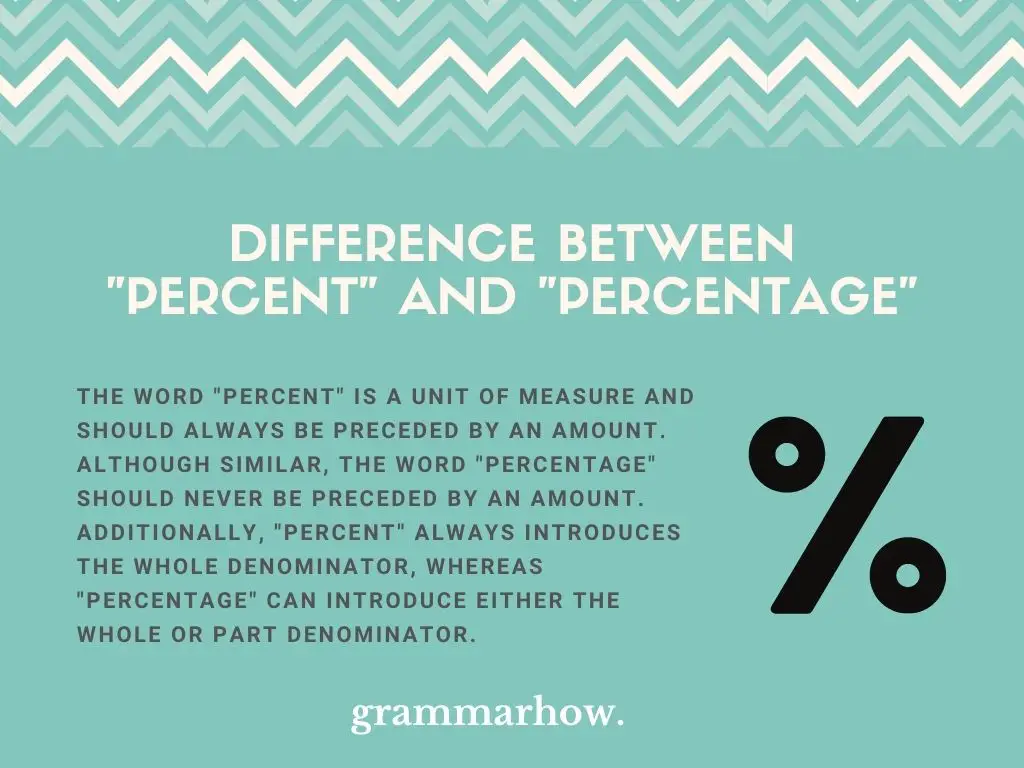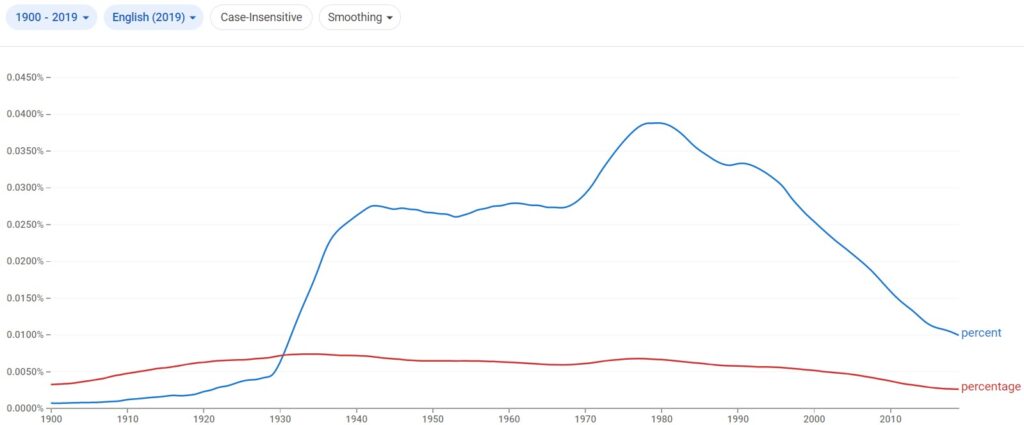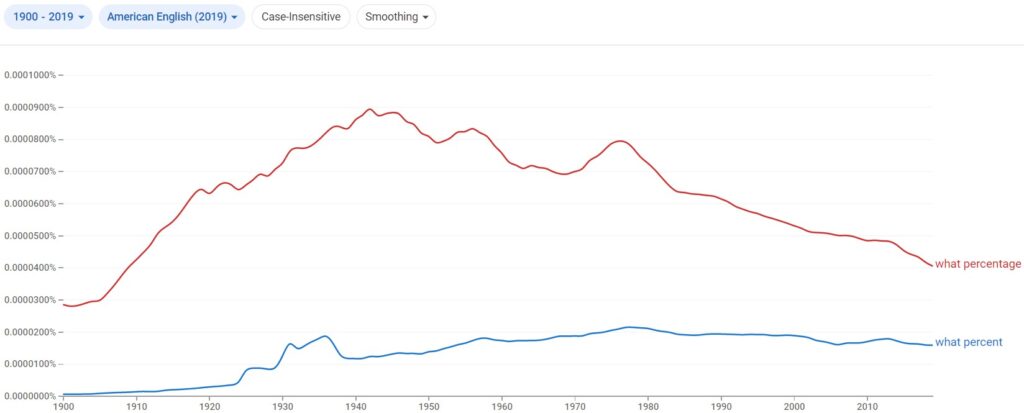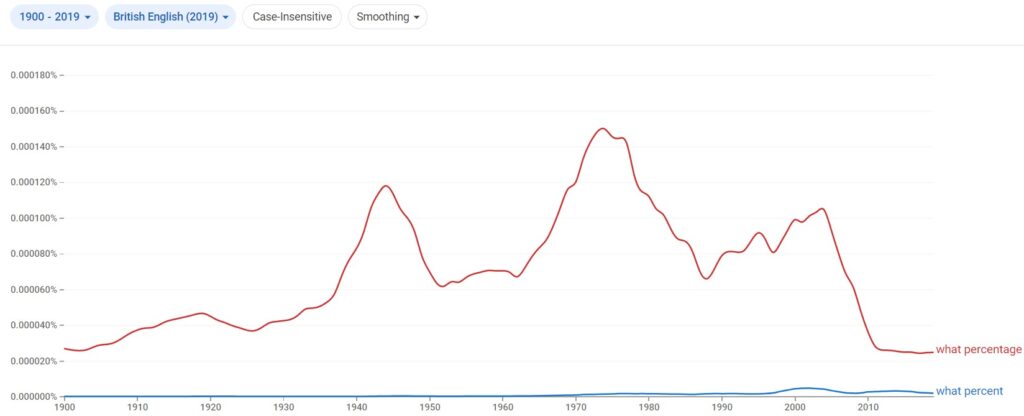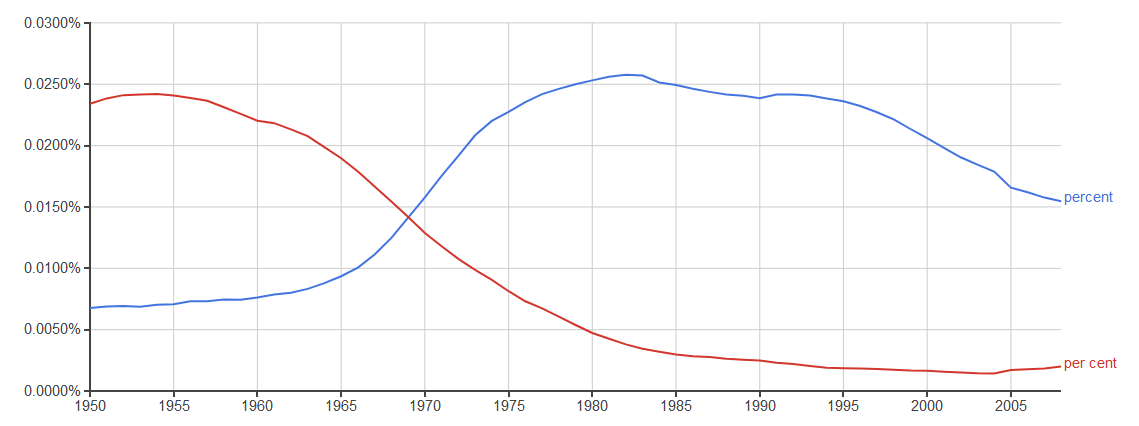The words “percent” and “percentage” are so similar that many people use them interchangeably in conversation and the written word. Here we discuss whether that usage is appropriate and the proper conventions around when you should choose to use each.
What Is The Difference Between “Percent” And “Percentage”?
The word “percent” is a unit of measure and should always be preceded by an amount. Although similar, the word “percentage” should never be preceded by an amount. Additionally, “percent” always introduces the whole denominator, whereas “percentage” can introduce either the whole or part denominator.
The word “percent” can sometimes be used/act as an adverb in a sentence. The word “percentage” is always a noun.
When Should I Use “Percent”?
Use “percent” when you want to indicate a specified amount or one part in every hundred. You must always have a specific amount indicated and that amount must come before the word “percent.”
When indicating a percent in a sentence, you must always write out the number and then follow the number immediately with the word percent (i.e., five percent). You can also choose to write out the number in the numeral form and use the “%” sign immediately after it instead (i.e., 5%).
Both of those options are correct. However, you can not write out the number in words and use the “%” sign and should not use the numeral with the word “percent” (i.e., 5 percent).
These example sentences show the proper usage of the word “percent.”
- In the survey we conducted, only fifteen percent of people were in favor of the changes taking place.
- The class was evenly divided as 50% of the students were boys and 50% were girls.
- The loan has a four percent interest rate for 10 years.
- The suspect claimed he was being one hundred percent truthful when he was questioned by the police.
- That candy bar has 18% sugar in it.
- I got a ninety percent on the geometry test that I took the other day.
- Ninety-five percent of the time I walk to work in the morning, but some days I’m running late and have to drive.
When Should I Use “Percentage”?
Use “percentage” when you are talking about things in a more general sense, or are not referring to a specific number (although it can be a range of specific numbers). The word “percentage” is never preceded by a specific number in a sentence.
When describing a specific range of numbers, the word “percentage” is preceded by the word “the” and followed by the word “of.” Therefore, the complete phrase when using the word “percentage” this way is “the percentage of.”
When the noun “percentage” does not refer to a range of specific numbers in a sentence, it uses the noun determiner “a” instead of “the.” It must also be preceded by an adjective (i.e., large, significant, small) to create a phrase such as “a large percentage of.”
Here are some examples that show “percentage” properly used in a sentence.
- I’d say that the percentage of my paycheck that goes towards food each month is between 25 to 30 percent.
- A large percentage of the population was exposed to the chickenpox virus as a child.
- There will probably be a small percentage of possibility for rain showers in the morning on Saturday.
- Each week, Matt puts a small percentage of his paycheck into a savings account for emergencies.
- I think the percentage of people that didn’t reply to the invitation was about 5% to 10%.
- I’d figure that only a small percentage of people don’t enjoy eating pizza.
Are “Percent” And “Percentage” Interchangeable?
The words “percent” and “percentage” are not interchangeable although they are closely related. The word “percent” must always be used when referring to a specific amount. The word “percentage” must always be used when speaking without a number or for a range of numbers.
Is “Percent” Or “Percentage” Used The Most?
The word “percent” is used more often than the word “percentage,” although both words have been used regularly throughout history.
This Google Ngram Viewer shows the usage of the two words from the year 1900 until today. As you can see, the usage word “percentage” has remained steady through the years.
The word “percent” experienced a significant rise in usage around the year 1930 and continued to rise until it fell back down and started to level out around the year 2014.
Is It “Percent Of” Or “Percentage Of”?
You can use either the phrase “percent of” or “percentage of” depending on the context of your sentence. Keep in mind that the word “percent” must always be preceded by a specific number, even when saying “percent of.”
Here is an example of both phrases used correctly:
- I was told that twenty percent of people surveyed wished they took more vacations.
- The percentage of applicants who didn’t get accepted to the university was 25 to 30 percent.
Is It “What Percent” Or “What Percentage”?
You can use both the phrases “what percent” or “what percentage.” It depends on the answer that you expect to get. If you expect an exact number, “what percent” is appropriate. If you are not looking for an exact number “what percentage” should be used.
You may also like: “How Many Percent”, “How Much Percent”, or “What Percent”?
Is “What Percent” And “What Percentage” Used Differently In The US And The UK?
In both the US and the UK, the phrase “what percentage” is used more often than “what percent.” However, in the UK, the phrase “what percent” is almost never used at all, in the US, it is just used slightly less.
This Google Ngram Viewer shows the usage of the two phrases in American English. As you can see, both phrases are used regularly, even though “what percentage” is used more.
This Google Ngram Viewer shows the UK usage of the two phrases. From this analysis, you can see that the phrase “what percent” is almost non-existent in British English and has been throughout history.
Is It “Percent Point” Or “Percentage Point”?
The proper phrase to use is “percentage point.” A “percentage point” is the mathematical difference between two percentages. However, the answer is not an exact percent, so you would not say “percent point.” For example, a 20% difference in two numbers, could actually equal just 2 “percentage points.”
You may also like:
Do You Put a Space Before a Percent Sign? Full Explanation
Is Percentage Singular or Plural? (Helpful Examples)
Martin holds a Master’s degree in Finance and International Business. He has six years of experience in professional communication with clients, executives, and colleagues. Furthermore, he has teaching experience from Aarhus University. Martin has been featured as an expert in communication and teaching on Forbes and Shopify. Read more about Martin here.
глагол ↓
- выводить отметку на письменном экзамене
He was not percented. — Отметку ему не поставили.
существительное ↓
- процент: одна сотая часть
The value has increased half a percent. — Значение выросло на половину процента.
80 percent of the population voted. — Проголосовало восемьдесят процентов населения.
- процентное содержание, доля, степень, коэффициент
percent of harmonic distortion — коэффициент нелинейных искажений
deafness percent — степень глухоты
wear-out percent — процент износа
- знак процента (%)
прилагательное ↓
- процентный, выраженный в процентах
percent alive — процент выживаемости; выживаемость в процентах
percent radiation dose — процентная доза ионизирующего излучения
percent completion — процент выполнения работ
percent downtime — непроизводительное время в процентах; время простоя в процентах
- относительный
percent elongation — относительное удлинение в процентах; относительное удлинение
- выборочный
percent test — выборочное испытание
Мои примеры
Словосочетания
a grade of 90 percent or better — оценка в девяносто процентов баллов или больше 
Savings of up to 50 percent are obtainable. — Возможна экономия до пятидесяти процентов. 
percent reduction — степень обжатия 
percent ripple — волнистость 
mean absolute percent error — средняя абсолютная ошибка в процентах 
percent failing — процент изделий, вышедших из строя 
hundred-percent — законченный 
Примеры с переводом
Inflation is close to 7 percent. 
Инфляция приближается к 7 процентам.
He got 56 percent of the votes. 
Он получил 56% голосов избирателей.
Sixty percent of people voted no. 
Шестьдесят процентов людей проголосовали «против».
I’m not a hundred percent sure where she lives. 
Я не на сто процентов уверен, где она живёт.
The retail markup on their products is 25 percent. 
Розничная наценка на их продукцию составляет двадцать пять процентов.
It is an investment that pays 5 percent. 
Это капиталовложение, приносящее пять процентов дохода.
The success rates approach 90 percent. 
Вероятность успешного исхода приближается к девяноста процентам.
ещё 23 примера свернуть
Примеры, ожидающие перевода
Harkin won 74 percent of the votes cast. 
Leakages of about 30 percent were reported. 
Sales rose an anemic 0.5 percent last quarter. 
Для того чтобы добавить вариант перевода, кликните по иконке ☰, напротив примера.
Возможные однокоренные слова
cent — цент, гроши
century — век, столетие, центурия, сотня, сто фунтов стерлингов, сто долларов
percentage — процент, доля, часть, процентный
percenter — ростовщик, процентщик
percental — исчисляемый в процентах
«Percent» redirects here. For the symbol, see Percent sign.
«Per cent» redirects here. For the unit of currency, see cent (currency).
A pie chart showing the percentage by web browser visiting Wikimedia sites (April 2009 to 2012)
In mathematics, a percentage (from Latin per centum ‘by a hundred’) is a number or ratio expressed as a fraction of 100. It is often denoted using the percent sign (%),[1] although the abbreviations pct., pct, and sometimes pc are also used.[2] A percentage is a dimensionless number (pure number); it has no unit of measurement.
Examples
For example, 45% (read as «forty-five per cent») is equal to the fraction 45/100, the ratio 45:55 (or 45:100 when comparing to the total rather than the other portion), or 0.45.
Percentages are often used to express a proportionate part of a total.
(Similarly, one can also express a number as a fraction of 1,000, using the term «per mille» or the symbol «‰«.)
Example 1
If 50% of the total number of students in the class are male, that means that 50 out of every 100 students are male. If there are 500 students, then 250 of them are male.
Example 2
An increase of $0.15 on a price of $2.50 is an increase by a fraction of 0.15/2.50 = 0.06. Expressed as a percentage, this is a 6% increase.
While many percentage values are between 0 and 100, there is no mathematical restriction and percentages may take on other values.[3] For example, it is common to refer to 111% or −35%, especially for percent changes and comparisons.
History
In Ancient Rome, long before the existence of the decimal system, computations were often made in fractions in the multiples of 1/100. For example, Augustus levied a tax of 1/100 on goods sold at auction known as centesima rerum venalium. Computation with these fractions was equivalent to computing percentages.
As denominations of money grew in the Middle Ages, computations with a denominator of 100 became increasingly standard, such that from the late 15th century to the early 16th century, it became common for arithmetic texts to include such computations. Many of these texts applied these methods to profit and loss, interest rates, and the Rule of Three. By the 17th century, it was standard to quote interest rates in hundredths.[4]
Percent sign
The term «percent» is derived from the Latin per centum, meaning «hundred» or «by the hundred».[5][6]
The sign for «percent» evolved by gradual contraction of the Italian term per cento, meaning «for a hundred». The «per» was often abbreviated as «p.»—eventually disappeared entirely. The «cento» was contracted to two circles separated by a horizontal line, from which the modern «%» symbol is derived.[7]
Calculations
The percent value is computed by multiplying the numeric value of the ratio by 100. For example, to find 50 apples as a percentage of 1250 apples, one first computes the ratio 50/1250 = 0.04, and then multiplies by 100 to obtain 4%. The percent value can also be found by multiplying first instead of later, so in this example, the 50 would be multiplied by 100 to give 5,000, and this result would be divided by 1250 to give 4%.
To calculate a percentage of a percentage, convert both percentages to fractions of 100, or to decimals, and multiply them. For example, 50% of 40% is:
- 50/100 × 40/100 = 0.50 × 0.40 = 0.20 = 20/100 = 20%.
It is not correct to divide by 100 and use the percent sign at the same time; it would literally imply division by 10,000. For example, 25% = 25/100 = 0.25, not 25%/100, which actually is 25⁄100/100 = 0.0025. A term such as 100/100% would also be incorrect, since it would be read as 1 percent, even if the intent was to say 100%.
Whenever communicating about a percentage, it is important to specify what it is relative to (i.e., what is the total that corresponds to 100%). The following problem illustrates this point.
- In a certain college 60% of all students are female, and 10% of all students are computer science majors. If 5% of female students are computer science majors, what percentage of computer science majors are female?
We are asked to compute the ratio of female computer science majors to all computer science majors. We know that 60% of all students are female, and among these 5% are computer science majors, so we conclude that 60/100 × 5/100 = 3/100 or 3% of all students are female computer science majors. Dividing this by the 10% of all students that are computer science majors, we arrive at the answer: 3%/10% = 30/100 or 30% of all computer science majors are female.
This example is closely related to the concept of conditional probability.
Variants of the percentage calculation
The calculation of percentages is carried out and taught in different ways depending on the prerequisites and requirements. In this way, the usual formulas can be obtained with proportions, which saves them from having to remember them. In so-called mental arithmetic, the intermediary question is usually asked what 100% or 1% is (corresponds to).
Example:
42 kg is 7%. How much is (corresponds to) 100%?
Given are W (percentage) and p % (percentage).
We are looking for G (basic value).
| With general formula | With own ratio equation (Proportion) | With “What is 1%?” (Rule of 3) 
|
|---|---|---|

multiple rearrangements result in: |

simple conversion yields: |

without changing the last counter is: |
| Advantage: • One formula for all tasks |
Advantages: • Without a formula • Easy to change over if the size you are looking for — here G — is in the top left of the counter. |
Advantages: • Without a formula • Simple rule of three — here as a chain of equations • Application for mental arithmetic |
Percentage increase and decrease
Due to inconsistent usage, it is not always clear from the context what a percentage is relative to. When speaking of a «10% rise» or a «10% fall» in a quantity, the usual interpretation is that this is relative to the initial value of that quantity. For example, if an item is initially priced at $200 and the price rises 10% (an increase of $20), the new price will be $220. Note that this final price is 110% of the initial price (100% + 10% = 110%).
Some other examples of percent changes:
- An increase of 100% in a quantity means that the final amount is 200% of the initial amount (100% of initial + 100% of increase = 200% of initial). In other words, the quantity has doubled.
- An increase of 800% means the final amount is 9 times the original (100% + 800% = 900% = 9 times as large).
- A decrease of 60% means the final amount is 40% of the original (100% – 60% = 40%).
- A decrease of 100% means the final amount is zero (100% – 100% = 0%).
In general, a change of x percent in a quantity results in a final amount that is 100 + x percent of the original amount (equivalently, (1 + 0.01x) times the original amount).
Compounding percentages
Percent changes applied sequentially do not add up in the usual way. For example, if the 10% increase in price considered earlier (on the $200 item, raising its price to $220) is followed by a 10% decrease in the price (a decrease of $22), then the final price will be $198—not the original price of $200. The reason for this apparent discrepancy is that the two percent changes (+10% and −10%) are measured relative to different quantities ($200 and $220, respectively), and thus do not «cancel out».
In general, if an increase of x percent is followed by a decrease of x percent, and the initial amount was p, the final amount is p(1 + 0.01x)(1 − 0.01x) = p(1 − (0.01x)2); hence the net change is an overall decrease by x percent of x percent (the square of the original percent change when expressed as a decimal number). Thus, in the above example, after an increase and decrease of x = 10 percent, the final amount, $198, was 10% of 10%, or 1%, less than the initial amount of $200. The net change is the same for a decrease of x percent, followed by an increase of x percent; the final amount is p(1 — 0.01x)(1 + 0.01x) = p(1 − (0.01x)2).
This can be expanded for a case where one does not have the same percent change. If the initial amount p leads to a percent change x, and the second percent change is y, then the final amount is p(1 + 0.01x)(1 + 0.01y). To change the above example, after an increase of x = 10 percent and decrease of y = −5 percent, the final amount, $209, is 4.5% more than the initial amount of $200.
As shown above, percent changes can be applied in any order and have the same effect.
In the case of interest rates, a very common but ambiguous way to say that an interest rate rose from 10% per annum to 15% per annum, for example, is to say that the interest rate increased by 5%, which could theoretically mean that it increased from 10% per annum to 10.05% per annum. It is clearer to say that the interest rate increased by 5 percentage points (pp). The same confusion between the different concepts of percent(age) and percentage points can potentially cause a major misunderstanding when journalists report about election results, for example, expressing both new results and differences with earlier results as percentages. For example, if a party obtains 41% of the vote and this is said to be a 2.5% increase, does that mean the earlier result was 40% (since 41 = 40 × (1 + 2.5/100)) or 38.5% (since 41 = 38.5 + 2.5)?
In financial markets, it is common to refer to an increase of one percentage point (e.g. from 3% per annum to 4% per annum) as an increase of «100 basis points».
Word and symbol
In most forms of English, percent is usually written as two words (per cent), although percentage and percentile are written as one word.[8] In American English, percent is the most common variant[9] (but per mille is written as two words).
In the early 20th century, there was a dotted abbreviation form «per cent.«, as opposed to «per cent«. The form «per cent.» is still in use in the highly formal language found in certain documents like commercial loan agreements (particularly those subject to, or inspired by, common law), as well as in the Hansard transcripts of British Parliamentary proceedings. The term has been attributed to Latin per centum.[10] The concept of considering values as parts of a hundred is originally Greek.[citation needed] The symbol for percent (%) evolved from a symbol abbreviating the Italian per cento. In some other languages, the form procent or prosent is used instead. Some languages use both a word derived from percent and an expression in that language meaning the same thing, e.g. Romanian procent and la sută (thus, 10% can be read or sometimes written ten for [each] hundred, similarly with the English one out of ten). Other abbreviations are rarer, but sometimes seen.
Grammar and style guides often differ as to how percentages are to be written. For instance, it is commonly suggested that the word percent (or per cent) be spelled out in all texts, as in «1 percent» and not «1%». Other guides prefer the word to be written out in humanistic texts, but the symbol to be used in scientific texts. Most guides agree that they always be written with a numeral, as in «5 percent» and not «five percent», the only exception being at the beginning of a sentence: «Ten percent of all writers love style guides.» Decimals are also to be used instead of fractions, as in «3.5 percent of the gain» and not «3+1⁄2 percent of the gain». However the titles of bonds issued by governments and other issuers use the fractional form, e.g. «3+1⁄2% Unsecured Loan Stock 2032 Series 2″. (When interest rates are very low, the number 0 is included if the interest rate is less than 1%, e.g. «0+3⁄4% Treasury Stock», not «3⁄4% Treasury Stock».) It is also widely accepted to use the percent symbol (%) in tabular and graphic material.
In line with common English practice, style guides—such as The Chicago Manual of Style—generally state that the number and percent sign are written without any space in between.[11]
However, the International System of Units and the ISO 31-0 standard require a space.[12][13]
Other uses
Percent used to indicate a road’s steepness down.
The word «percentage» is often a misnomer in the context of sports statistics, when the referenced number is expressed as a decimal proportion, not a percentage: «The Phoenix Suns’ Shaquille O’Neal led the NBA with a .609 field goal percentage (FG%) during the 2008–09 season.» (O’Neal made 60.9% of his shots, not 0.609%.) Likewise, the winning percentage of a team, the fraction of matches that the club has won, is also usually expressed as a decimal proportion; a team that has a .500 winning percentage has won 50% of their matches. The practice is probably related to the similar way that batting averages are quoted.
As «percent» it is used to describe the steepness of the slope of a road or railway, formula for which is 100 × rise/run which could also be expressed as the tangent of the angle of inclination times 100. This is the ratio of distances a vehicle would advance vertically and horizontally, respectively, when going up- or downhill, expressed in percent.
Percentage is also used to express composition of a mixture by mass percent and mole percent.
Visualisation of 1%, 1‰, 1‱, 1 pcm and 1 ppm as fractions of the large block (larger version)
- Percentage point difference of 1 part in 100
- Per mille (‰) 1 part in 1,000
- Basis point (bp) difference of 1 part in 10,000
- Permyriad (‱) 1 part in 10,000
- Per cent mille (pcm) 1 part in 100,000
- Grade (slope)
- Centiturn
Practical applications
- Baker percentage
- Volume percent
See also
- 1000 percent
- Relative change and difference
- Percent difference
- Percentage change
- Parts-per notation
- Per-unit system
- Percent point function
References
- ^ «Introduction to Percents». mathsisfun.com. Retrieved 28 August 2020.
- ^ Dakers, Marion (7 January 2015). «Eurozone Officially Falls into Deflation, Piling Pressure on ECB». The Daily Telegraph. Retrieved 27 December 2019.
- ^ Bennett, Jeffrey; Briggs, William (2005), Using and Understanding Mathematics / A Quantitative Reasoning Approach (3rd ed.), Pearson Addison Wesley, p. 134, ISBN 0-321-22773-5
- ^ Smith, D.E. (1958) [1951]. History of Mathematics. Vol. 2. Courier Dover Publications. pp. 247–249. ISBN 0-486-20430-8.
- ^ American Heritage Dictionary of the English Language, 3rd ed. (1992) Houghton Mifflin
- ^ «Definition of PERCENT». www.merriam-webster.com. Retrieved 28 August 2020.
- ^ Smith p. 250
- ^ Brians, Paul. «Percent/per cent». Common Errors in English Usage. Washington State University. Retrieved 22 November 2010.
- ^ «Percent (per cent)». Oxford Dictionaries. Retrieved 22 November 2010.[dead link]
- ^ «Percent». Oxford English Dictionary (Online ed.). Oxford University Press. (Subscription or participating institution membership required.)
- ^
«The Chicago Manual of Style». University of Chicago Press. 2003. Retrieved 5 January 2007. - ^
«The International System of Units» (PDF). International Bureau of Weights and Measures. 2006. Retrieved 6 August 2007. - ^
«ISO 31-0 — Quantities and units – Part 0: General principles». International Organization for Standardization. 22 December 1999. Retrieved 5 January 2007.
External links
The dictionary definition of percentage at Wiktionary
The words percent and percentage are closely related—does it matter how they
are used in a sentence? Read this word usage tip to find out.
The rule for using percent and percentage is straightforward. The word percent (or the
symbol %) accompanies a specific number, whereas the more general word percentage is used without
a number.
Examples
percent (adverb, noun): of each hundred
Example
Fifteen percent of the control group responded to treatment with Drug A.
Example
More than 95% of the participants who responded to the survey reported positive results.
percentage (noun): part of a whole that can be expressed in
hundredths
Example
A large percentage of the population has been exposed to rotavirus.
Example
The percentage of the population exposed to rotavirus is between 70% and 75%.
Quick Tips: Percent vs Percentage
- Always write out the number and the word percent at the beginning of a sentence (eg, «Ten
percent…»). - The noun percentage requires an adjective to describe its size (eg, «a large percentage») when it does
not refer to specific numbers in the sentence. - Some style guides recommend a numeral and the symbol % rather than the word percent, even if the
number is less than 10 (eg, «A total of 5%…»).
Sources
Iverson C, Christiansen S, Flanagin A, et al. AMA Manual of Style:
A Guide for Authors and Editors. 10th ed. New York, NY: Oxford University Press; 2007.
Merriam-Webster’s Collegiate Dictionary. 11th ed. Springfield, MA: Merriam-Webster, Inc.; 2007.
Do you have a question or comment about this tip? Simply
contact me online and I’ll be pleased to help.
We’ve been told that putting 110% into anything is mathematically impossible. But we’re proofreaders, not mathematicians! As such, we’re not going to let math get in the way of putting everything we have into solving your writing problems. Today, for example, we’re looking at writing percentages.
Words and Numbers
As with any numbers, percentages can be written as either words or numbers:
Words: Around nine percent of people dislike coffee.
Numbers: Approximately 91% of people like coffee.
The examples above reflect three important guidelines when writing percentages:
- Numbers up to ten are usually written as words, while larger numbers are written as numerals
- When a percentage is written as a word, it should be followed by “percent”
- When a percentage is written as a numeral, it should be followed by the “%” sign
However, this can vary depending on the context (e.g., measurements in scientific writing are almost always written as numerals, even for numbers under ten). It’s therefore a good idea to check your style guide for advice on how to write percentages.
Percent vs. Per Cent
The question we’re asked most often about writing percentages is whether to use “percent” or “per cent.” Ultimately, though, this doesn’t really matter: both are accepted spellings of this term.
Find this useful?
Subscribe to our newsletter and get writing tips from our editors straight to your inbox.
Again, we recommend checking your style guide if you have one, as some publishers and colleges have a preference. And “percent” is much more common these days than “per cent.” But other than that, the main thing is picking one spelling and using it consistently throughout your work.
When to Use “Percentage”
Finally, we have the word “percentage.” Although similar to “percent,” this word has a slightly different usage: “Percent” is used with specific numbers, while “percentage” is used when referring to a general or non-specific amount of something. For example:
A small percentage of the forms were coffee stained.
Almost seven percent of the forms were coffee stained.
As shown above, you should use “percentage” when the exact amount is unspecified.

